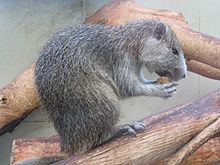Hystricognathi
| Hystricognathi Temporal range: Late Eocene–Recent |
|
|---|---|
 |
|
| Capromys pilorides | |
| Scientific classification | |
| Kingdom: | Animalia |
| Phylum: | Chordata |
| Class: | Mammalia |
| Order: | Rodentia |
| Suborder: | Hystricomorpha |
| Infraorder: |
Hystricognathi Tullberg, 1899 |
| Families | |
|
Hystricidae |
|
Hystricidae
†Bathyergoididae
Bathyergidae
†Myophiomyidae
†Diamantomyidae
†Phiomyidae
†Kenyamyidae
Petromuridae
Thryonomyidae
Erethizontidae
Chinchillidae
†Neoepiblemidae
Dinomyidae
†Cephalomyidae
†Eocardiidae
Caviidae
Dasyproctidae
Cuniculidae
Ctenomyidae
Octodontidae
Abrocomidae
Echimyidae
Myocastoridae
Capromyidae
†Heptaxodontidae
The Hystricognathi are an infraorder of rodents, distinguished from other rodents by the bone structure of their skulls. The masseter medialis (a jaw muscle) passes partially through the infraorbital foramen and connects to the bone on the opposite side. This, together with their lack of an infraorbital plate and the relative size of the infraorbital foramen, distinguishes hystricognaths from other rodent groups.
...
Wikipedia
